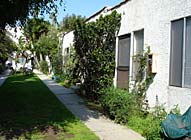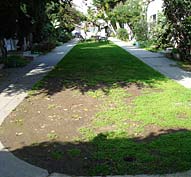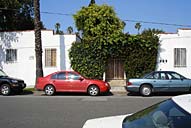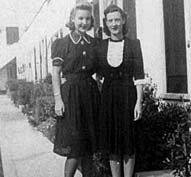




125 Pacific Avenue


125 Pacific Christie Court
photo by Michael Grandcolas

View of circular walkway
photo by Michael Grandcolas

Another view
photo by Michael Grandcolas

Girls at the 125 Pacific Bungalow Court
- photo courtesy of Lynne Bronstein
The property was landmarked on June 14th, 2004. It became noteworthy to the City earlier in the year when one of the owners, Adam Pasori, had applied for a demolition permit; he wanted to replace the existing building with a new project designed by Ralph Mechur.
Showing that people can make a difference, past and present tenants as well as neighbors asked the commission to landmark the property. The residents and the community did extensive historical and architectural research to demonstrate that the historical value of this Mission Revival style bungalow court at 125 Pacific Avenue in Ocean Park was worthy of landmarking. A former tenant noted that under its original address of 121-131 Pacific Street, the courtyard building was Santa Monica ’s first motel court.
The Santa Monica Mirror noted that tenant Rachel White discovered the building had once been known as “Christie Court” and was mentioned under that name in the book "Looking At Santa Monica" by Jim Lunsford. She noted that other materials at the Santa Monica Library that might substantiate its history were in storage during the library’s reconstruction.
Mary Hubble, who identified herself as living in the Ocean Park area, said: “When you pass by it on the street, it’s like stepping back in time.”
One tenant of Christie Court announced that a petition calling for preservation of the building had garnered 271 signatures from residents of Santa Monica.
Architect Ralph Mechur, designer of the proposed new project that would have been built at 125 Pacific countered the tenant praise by noting that the existing building has sustained fire damage and has inadequate plumbing, electricity and foundations. He went on to say that it has no “street presence” and that it was not the best example of this kind of architecture.
While some Commissioners admitted they had originally been skeptical about the merits of Christie Court, they said they had been won over by the research and commitment of the tenants. “Obviously this courtyard has brought a lot of people to a pretty co-operative state,” said Commissioner Nina Fresco. With no dissenters, the Commission voted to nominate 125 Pacific Street for landmark status.
Constructed in 1924 in the Mission Revival style, the Landmarks Commission found that this property met three of the six criteria for individual landmark status. City reports say it was distinguished from the other bungalow courts by its proximity to the ocean and the beach entertainment zone that provided the historical context for Ocean Park. It noted the large number of units provided for in the structure - 24 units are contained in a U-shaped structure wrapped around a central courtyard. Additionally, the courtyard is a landscaped green space instead of the concrete or driveway character of many of the other courtyard bungalows.
The Landmark Commission agreed Christie Court was worthy of landmarking because it met the following criteria 1).”It exemplifies, symbolizes, or manifests elements of the cultural, social, economic, political or architectural history of the city), 6) (“It has a unique location, a singular physical characteristic, or is an established and familiar visual feature of a neighborhood, community or the City”), and possibly 4)…”historical type valuable to ..study.”) When the Commission then voted to grant landmark status to Christie Court, the decision brought applause from the neighbors and tenants, many of whom had been afraid of being uprooted from their homes at the property.
When you look at Christie Court, you will note that the building has undergone a variety of architectural alterations over time. The original doors and decorations were replaced in the mid-1940s. Later renovation saw the use of bars over windows; and the replacement of the windows with aluminum sliders. The façade has been recovered and the gate in the front of the courtyard replaced. Enter the property, and you may be a bit confused as to why they chose this to landmark, but note that it was the diligence of the community that saved Christie Court.